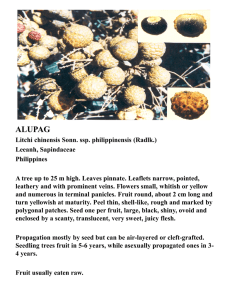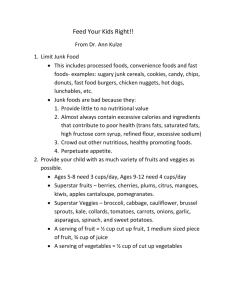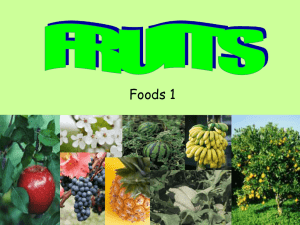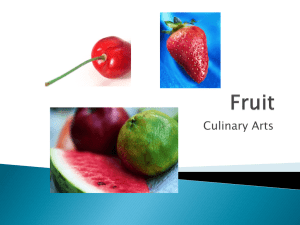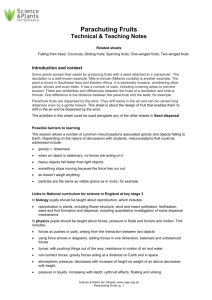Lab #2 - Fruit ID
advertisement
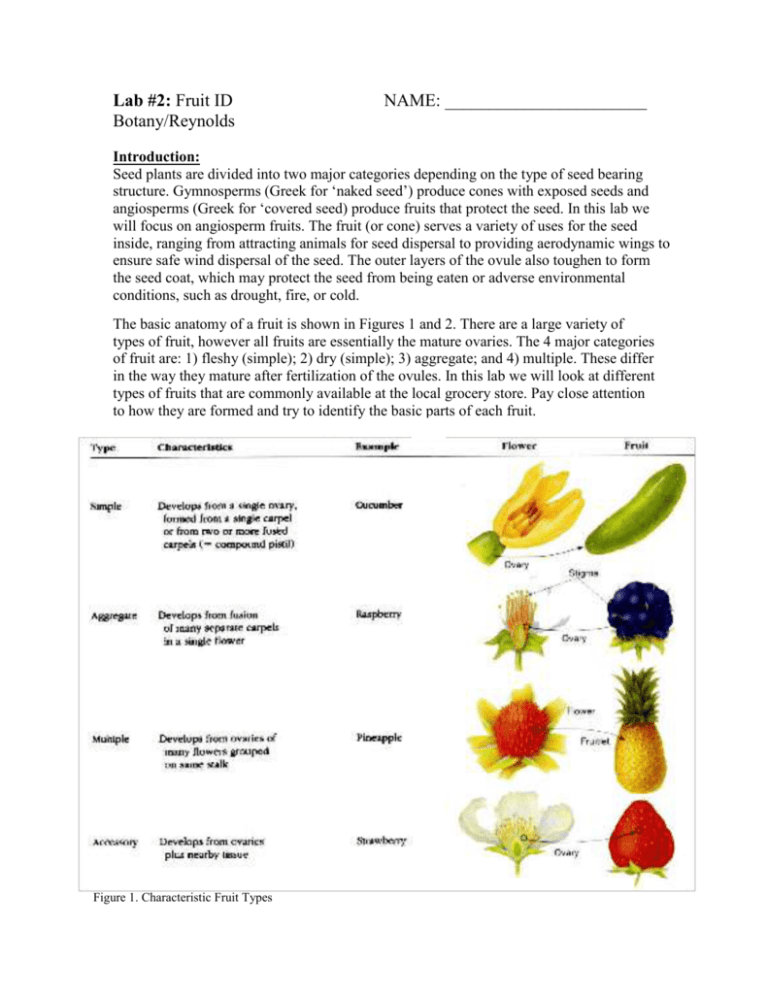
Lab #2: Fruit ID Botany/Reynolds NAME: _______________________ Introduction: Seed plants are divided into two major categories depending on the type of seed bearing structure. Gymnosperms (Greek for ‘naked seed’) produce cones with exposed seeds and angiosperms (Greek for ‘covered seed) produce fruits that protect the seed. In this lab we will focus on angiosperm fruits. The fruit (or cone) serves a variety of uses for the seed inside, ranging from attracting animals for seed dispersal to providing aerodynamic wings to ensure safe wind dispersal of the seed. The outer layers of the ovule also toughen to form the seed coat, which may protect the seed from being eaten or adverse environmental conditions, such as drought, fire, or cold. The basic anatomy of a fruit is shown in Figures 1 and 2. There are a large variety of types of fruit, however all fruits are essentially the mature ovaries. The 4 major categories of fruit are: 1) fleshy (simple); 2) dry (simple); 3) aggregate; and 4) multiple. These differ in the way they mature after fertilization of the ovules. In this lab we will look at different types of fruits that are commonly available at the local grocery store. Pay close attention to how they are formed and try to identify the basic parts of each fruit. Figure 1. Characteristic Fruit Types Simple fleshy fruits include berries, pepos, hesperidia, drupes, and pomes. A berry is a simple fruit with one or many seeds surrounded by a fleshy pericarp. A large variery of fruit families have berries as fruits. A pepo is the characteristic fruit of the Cucumber Family (Curcurbitaceae). It is a berry with a thick rind, like a watermelon. The Citrus Family (Rutaceae) has a characteristic fruit called a hesperidium. These berries have a thick leathery rind and thin partitions between the sections of the fruits. A drupe is a single seeded Figure 2. Anatomy of a Simple Fruit berry with a hard endocarp surrounding the seed. Some “nuts” are actually the inner endocarp layers of drupes. These are called “drupaceous nuts” and include walnuts, pecans, and coconuts (a dry drupe). Used in this sense, the pit of a plum or peach should also be called a nut! Finally, a pome (characteristic of the Rose Family, or Rosaceae) is a fleshy simple fruit where the edible, fleshy part is not part of the ovary, but rather part of the floral tissue. Dry fruits are further classified as dehiscent (splits open at maturity) and indehiscent (does not split open). Dehiscent dry fruits include legumes, siliques, and capsules. Legumes are characteristic of the Leguminosae group of the Bean Family (Fabaceae). These bean ‘pods’ actually represent the ‘seams’ of a folded over carpel within the pistil. The carpel contains the ovules within the pistil and thus contains the seeds of the fertilized fruit. Inside the pod, whether a bean or peanut, there are multiple seeds. Siliques and capsules are similar to the pods of legumes, but they have two (siliques) or three or more (capsules) carpels. Siliques are characteristic of the Mustard Family (Brassicaceae) and capsules are commonly found in many plant families. Indehiscent fruits include achenes, grains, samaras, and nuts. Achenes are single seeded fruits, usually formed in clusters. They are characteristic of the Sunflower Family (Asteraceae). When you eat sunflower seeds you are eating achenes, and when you blow dandelion seeds, you are dispersing achenes! Grains (caryopsis) are characteristic of the Grass Family (Poaceae). They are also single seeded fruits, but the seed coat is fused to the pericarp. Just a few grains, such as wheat, oats, corn, and rice feed billions of people on earth! Samaras are the ingenious invention of several tree families, such as Maples, Ashes, and Elms. These one-seeded fruits (double for Maples) have characteristic wings that allow for effective wind dispersal. Nuts are defined as one seeded fruits with a hard pericarp. True nuts, such as acorns, beech nuts, and chestnuts sit in a scaly cup called an involucre Multiple and aggregate fruits seem similar at first, but they differ in how they are formed. Aggregate fruits form from multiple carpels in a single flower. Blackberries, raspberries, and strawberries develop from a single flower in this way. In blackberries, each individual carpel forms a small drupe, which fuse into a cluster called a syncarp. Multiple fruits, like the pineapple, actually form from multiple flowers on a single inflorescence. As the fruits mature, they fuse together to form a single large fruit. In the case of a pineapple, each individual flower forms a berry and these berries join to form a pineapple. Lab - Fruit ID & Dissection Botany/Reynolds Fruit Type Drupe Pome Berry Pepo Hesperidium Legume Capsule Achene Grain (Caryopsis) Multiple Aggregate Synconium Nut Seed (Kernel) Fruit Name NAME: __________________ Plant Family Characteristics (Scientific Name - if you don’t know, look it up!) (Simple/Complex? Fleshy/Dry? Dehiscent/Indehiscent?) Discussion Questions (research using the internet if needed!): 1) What is an accessory fruit? How is it different from other fruit types? Give an example. 2) What is parthenocarpy? Which of the fruits from today’s lab is parthenocarpic? 3) What is the botanical definition of a nut? Give an example from today’s lab of a nut and an example of a fruit commonly misidentified as a nut. 4) Many fruits and/or seeds are commonly used as spices, such as black pepper from today’s lab. List 3 other fruits commonly used as spices and describe them. 5) A fruits major function is to aid with seed dispersal. One fruit we didn’t look at today is a pomegranate, a berry whose fleshy mesocarp is inedible. What is the edible part of the fruit called? How does this assist with seed dispersal?



